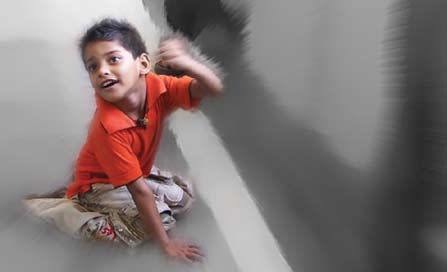Cerebral palsy is a disorder affecting one’s ability to move and maintain posture. Recent estimates reveal that India has more than four million cases of cerebral palsy, including over 200 children born affected every day.

Numerous assistive technology devices, ranging from electronic communication boards with pictures representing an individual’s daily needs to electronic speech synthesizers, have been designed to help individuals communicate easily and perform daily tasks. However, most devices need to interface with a computer which is yet to penetrate every Indian household, leaving communication to perform day-to-day tasks an everyday battle for most patients.
CePal, an infrared-based remote control developed by Dhirubhai Ambani Institute of Information and Communication Technology (DA-IICT), Gandhinagar, and now backed by National Trust (an autonomous organization of the Ministry of Social Justice and Empowerment in India), has finally won this losing battle for cerebral palsy patients.
This lightweight, low-cost device worn on the wrist, hand, or head allows people affected with cerebral palsy to operate remote-controlled electronic devices like TV, air-conditioner, lights, and fans.
“We took advantage of the fact that most equipment today comes with IR remote control. We used the IR receiver built into the device and directly operated it from ‘CePal.’ Thereafter, we directly generated the IR control signal needed by the device receiver to operate them; avoiding any intermediate device to act as a gateway. CePal by itself detects and differentiates the optimal tilt, thereby controlling the device. The device allows patients to switch on/off lights and fans, change the TV channel or volume, etc by movement,” says Prabhat Ranjan, professor, embedded systems and sensor networks, DA-IICT.
CePal uses a 2D accelerometer sensor (MMA6270QT) to detect motion. The detected movement is then sent to the analog-to-digital conversion (ADC) pin of an Atmel ATMega32 microcontroller chip. Thereafter, the microcontroller maps digital values from the ADC to IR control signals. The IR signals generated depend upon the IR protocol of the target device, the direction of the tilt, and the action to be performed based on the requirement of the patient.
A cut above the rest!
Started as a project by two students, Ramya and Pallavi, who wanted to work on assistive technology for the physically challenged, CePal has taken its first step in becoming the hope for cerebral palsy patients at Sparsh Pediatric Neuro Developmental Therapy Clinic in Ahmedabad. It is being used on cerebral palsy patients and is constantly improved based on feedback.
But, what makes CePal score over other assistive technologies? It is a complete solution, giving it an edge over its competitors. “Because of their complexity and huge prices, most existing devices are out of reach of the general population,” says Professor Ranjan, confident of conquering all the previous limitations.
A complete solution: Taking advantage of MEMS technology-based accelerometer, CePal senses movements with high accuracy. “We kept in mind that cerebral palsy patients do not have very fine control over movements. We put logic in the firmware to detect the tilts,” explains Professor Ranjan. Considering each patient’s movement capability and behavioral pattern may differ, CePal is also able to tune parameters to match needs. “CePal provided flexibility in firmware to adjust to the needs, making it easy to be customizable at the user’s end,” says Professor Ranjan.
Also, a work in progress would map the user-generated sound to meaningful voice outputs. A microphone is attached to the device that sends the sound input to the central processing unit via a wireless link, which is then mapped to prerecorded voice and corresponding meaningful response to be fed as the output to the speaker.
Cost-effective: CePal is much cheaper than other assistive technology products in the market. The use of the latest hardware components, including MEMS-based sensors, has helped to minimize the number of components, reducing overall costs. The use of Open Source technology has also made CePal cost-effective. “We used Open Source embedded system development tools and all development is done on the Linux platform. In particular, we used GNU GCC cross compilers for firmware development, which helped to cut costs,” says Professor Ranjan.
Easy to use: Usability of the device is of paramount importance for cerebral palsy patients and CePal ensures ease of use with its light weight. “We have used recent developments in technology to keep the weight low. The use of a microcontroller helped to reduce the component count. Further, the complete architecture is designed on a lightweight PCB to facilitate the user in using it without any hassle,” says Professor Ranjan.
Road ahead
National Trust will test CePal on a large scale in various parts of India. It has already won the HP Innovate Award in 2009. Professor Ranjan and National Trust hope to take CePal to the next level, making it the guiding light for aged people.
“We are looking at making CePal of great assistance to old people facing difficulty in the movement of limbs and people suffering from arthritis, paralysis, and other physical impairments like carpal tunnel syndrome caused by excessive use of keyboard and mouse,” says Professor Ranjan.
For reading the latest innovation articles: click here
The author is a business correspondent at EFY Bengaluru






